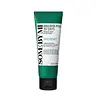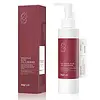What's inside
What's inside
 Key Ingredients
Key Ingredients

 Benefits
Benefits

 Concerns
Concerns

 Ingredients Side-by-side
Ingredients Side-by-side

Water
Skin ConditioningGlycerin
HumectantCentella Asiatica Extract
CleansingPalmitic Acid
EmollientStearic Acid
CleansingLauric Acid
CleansingMyristic Acid
CleansingPotassium Hydroxide
BufferingLauryl Betaine
CleansingButylene Glycol
HumectantPEG-100 Stearate
Glyceryl Stearate
EmollientBeeswax
Emulsion StabilisingMelaleuca Alternifolia Leaf Water
AntimicrobialSodium Methyl Cocoyl Taurate
CleansingPotassium Cocoyl Glycinate
Salicylic Acid
MaskingDipropylene Glycol
HumectantSodium Chloride
MaskingHydroxyacetophenone
AntioxidantMentha Piperita Oil
MaskingCaprylyl Glycol
Emollient1,2-Hexanediol
Skin ConditioningDisodium EDTA
Hydroxyethylcellulose
Emulsion StabilisingCalamine
AbsorbentGluconolactone
Skin ConditioningCitric Acid
BufferingPotassium Glycyrrhizinate
Skin ConditioningArtemisia Vulgaris Extract
Skin ConditioningMadecassoside
AntioxidantAsiaticoside
AntioxidantAsiatic Acid
Skin ConditioningMadecassic Acid
Skin ConditioningWater, Glycerin, Centella Asiatica Extract, Palmitic Acid, Stearic Acid, Lauric Acid, Myristic Acid, Potassium Hydroxide, Lauryl Betaine, Butylene Glycol, PEG-100 Stearate, Glyceryl Stearate, Beeswax, Melaleuca Alternifolia Leaf Water, Sodium Methyl Cocoyl Taurate, Potassium Cocoyl Glycinate, Salicylic Acid, Dipropylene Glycol, Sodium Chloride, Hydroxyacetophenone, Mentha Piperita Oil, Caprylyl Glycol, 1,2-Hexanediol, Disodium EDTA, Hydroxyethylcellulose, Calamine, Gluconolactone, Citric Acid, Potassium Glycyrrhizinate, Artemisia Vulgaris Extract, Madecassoside, Asiaticoside, Asiatic Acid, Madecassic Acid
Water
Skin ConditioningGlycerin
HumectantCoco-Betaine
CleansingDipropylene Glycol
HumectantPotassium Cocoyl Glycinate
Acrylates Copolymer
Potassium Cocoate
EmulsifyingSalicylic Acid
MaskingCaprylyl Glycol
EmollientHydroxyacetophenone
AntioxidantPolyglyceryl-10 Myristate
Skin ConditioningEthylhexylglycerin
Skin ConditioningHibiscus Syriacus Flower Extract
AntioxidantDipotassium Glycyrrhizate
HumectantGlycolic Acid
BufferingXylitylglucoside
HumectantAnhydroxylitol
HumectantXylitol
HumectantGlucose
HumectantWater, Glycerin, Coco-Betaine, Dipropylene Glycol, Potassium Cocoyl Glycinate, Acrylates Copolymer, Potassium Cocoate, Salicylic Acid, Caprylyl Glycol, Hydroxyacetophenone, Polyglyceryl-10 Myristate, Ethylhexylglycerin, Hibiscus Syriacus Flower Extract, Dipotassium Glycyrrhizate, Glycolic Acid, Xylitylglucoside, Anhydroxylitol, Xylitol, Glucose
 Reviews
Reviews

Ingredients Explained
These ingredients are found in both products.
Ingredients higher up in an ingredient list are typically present in a larger amount.
Caprylyl Glycol is a humectant and emollient, meaning it attracts and preserves moisture.
It is a common ingredient in many products, especially those designed to hydrate skin. The primary benefits are retaining moisture, skin softening, and promoting a healthy skin barrier.
Though Caprylyl Glycol is an alcohol derived from fatty acids, it is not the kind that can dry out skin.
This ingredient is also used as a preservative to extend the life of products. It has slight antimicrobial properties.
Learn more about Caprylyl GlycolDipropylene Glycol is a synthetically created humectant, stabilizer, and solvent.
This ingredient helps:
Dipropylene glycol is technically an alcohol, but it belongs to the glycol family (often considered part of the ‘good’ alcohols). This means it is hydrating and gentle on skin unlike drying solvent alcohols like denatured alcohol.
As a masking agent, Dipropylene Glycol can be used to cover the smell of other ingredients. However, it does not have a scent.
Studies show Dipropylene Glycol is considered safe to use in skincare.
Learn more about Dipropylene GlycolGlycerin is already naturally found in your skin. It helps moisturize and protect your skin.
A study from 2016 found glycerin to be more effective as a humectant than AHAs and hyaluronic acid.
As a humectant, it helps the skin stay hydrated by pulling moisture to your skin. The low molecular weight of glycerin allows it to pull moisture into the deeper layers of your skin.
Hydrated skin improves your skin barrier; Your skin barrier helps protect against irritants and bacteria.
Glycerin has also been found to have antimicrobial and antiviral properties. Due to these properties, glycerin is often used in wound and burn treatments.
In cosmetics, glycerin is usually derived from plants such as soybean or palm. However, it can also be sourced from animals, such as tallow or animal fat.
This ingredient is organic, colorless, odorless, and non-toxic.
Glycerin is the name for this ingredient in American English. British English uses Glycerol/Glycerine.
Learn more about GlycerinHydroxyacetophenone is antioxidant with skin conditioning and soothing properties. It also boosts the efficiency of preservatives.
This ingredient is not irritating or sensitizing.
Potassium Cocoyl Glycinate is an amino acid-based surfactant and cleaning agent. This ingredient can be derived from animals or plants. It may also be synthetically created from fatty acids of the coconut and glycine.
Potassium Cocoyl Glycinate is a gentle surfactant. Surfactants help gather the dirt, oil, and other pollutants from your skin to be rinsed away. It is a mild cleanser and naturally produces foam.
Salicylic Acid (also known as beta hydroxy acid or BHA) is a well-known ingredient for treating skin that struggles with acne and clogged pores. It exfoliates both the skin's surface and deep within the pores to help clear out buildup, control oil, and reduce inflammation.
Unlike AHAs (alpha hydroxy acids), salicylic acid is oil-soluble. This allows it to penetrate into pores which makes it especially effective for treating blackheads and preventing future breakouts.
Salicylic acid is also known for its soothing properties. It has a similar structure to aspirin and can calm inflamed or irritated skin, making it a good option for acne-prone skin that is also sensitive.
Concentrations of 0.5-2% are recognized by the U.S. FDA as an over-the-counter topical acne product.
It can cause irritation and/or dryness if one's skin already has a compromised moisture barrier, so it's best to focus on repairing that before introducing this ingredient into your routine.
While salicylic acid does not increase sun sensitivity, it’s still important to wear sunscreen daily to protect your skin.
If you are looking for the ingredient called BHA or Butylated Hydroxyanisole, click here.
Learn more about Salicylic AcidWater. It's the most common cosmetic ingredient of all. You'll usually see it at the top of ingredient lists, meaning that it makes up the largest part of the product.
So why is it so popular? Water most often acts as a solvent - this means that it helps dissolve other ingredients into the formulation.
You'll also recognize water as that liquid we all need to stay alive. If you see this, drink a glass of water. Stay hydrated!
Learn more about Water